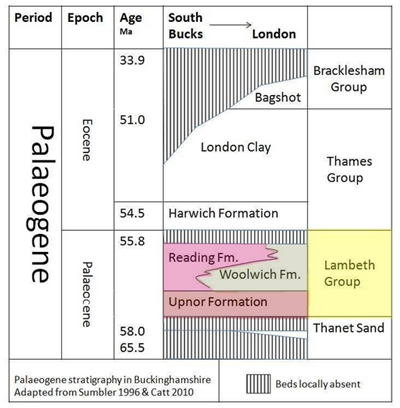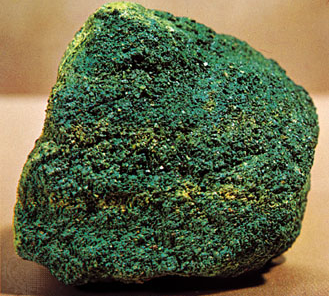Sarah Day reports on a geological detective story taking place beneath London's surface...
 In August 1988 24 year-old Clive Walker, an engineer for Thames Water, entered a small 2.3m wide shaft which formed part of the newly constructed Thames Water Ring Main, beneath Stoke Newington. The shaft led into the Upnor formation – a sandy, fossil-filled layer of rock which is part of a larger group of strata known as the Lambeth Group. The Lambeth Group itself extends throughout the London Basin, and for 25% of the city it’s within 30 metres of the surface.
In August 1988 24 year-old Clive Walker, an engineer for Thames Water, entered a small 2.3m wide shaft which formed part of the newly constructed Thames Water Ring Main, beneath Stoke Newington. The shaft led into the Upnor formation – a sandy, fossil-filled layer of rock which is part of a larger group of strata known as the Lambeth Group. The Lambeth Group itself extends throughout the London Basin, and for 25% of the city it’s within 30 metres of the surface.
Walker was inspecting the shaft for leaks. On reaching the bottom, he managed to say ‘I’ve got claustrophobia’ before collapsing. Attempting to rescue him, his 21 year old assistant James McCotter was also asphyxiated.
The two had fallen victim to ‘confined space hypoxia’. During the subsequent court case, soil sampling evidence was given, showing that the soil contained glauconite – a mineral already known to cause dangerously low concentrations of oxygen by oxidising on contact with air.
Ironically, the hazardous gas now causing problems for London’s industrial development is a product of the city’s industrial past.
‘From the early 1800s, the industrial revolution was a thirsty business’ explains Imperial College PhD student and Thames Water Engineering Geologist Time Newman. ‘Breweries, industry, everyone was pumping water from the lower aquifer, which included the Upnor Formation.’
Once full of water, pore spaces in the Upnor Formation became aerated. It was during that time, Tim suspects, that the oxidation occurred, and the gas trapped in pore spaces became deoxygenated.
 Following the 1988 tragedy, the tunnelling industry has declared glauconite to be a hazardous material, and stringent safety measures are in place wherever workers might come in contact with it. But a new paper published this month in the Quarterly Journal of Engineering Geology and Hydrogeology, of which Tim is a co-author, suggests glauconite may not be to blame. The real culprit is still out there.
Following the 1988 tragedy, the tunnelling industry has declared glauconite to be a hazardous material, and stringent safety measures are in place wherever workers might come in contact with it. But a new paper published this month in the Quarterly Journal of Engineering Geology and Hydrogeology, of which Tim is a co-author, suggests glauconite may not be to blame. The real culprit is still out there.
At Thames Water, Tim is currently working on the Tideway Thames Tunnel project – a proposed 7.2 metre diameter tunnel which will extend from Hammersmith to Beckton, easing the pressure on London’s overworked sewerage system. This will take it, and workers, directly through the Lambeth Group strata.
Image: glauconite sample
‘During our borehole investigation for the Thames Tunnel, two of our boreholes intersected pressurized gas at about 51 and 55 metres depth’ Tim explains. ‘Both drilling rigs encounted mini blow-outs. The gas was later found to be composed of as much as 98% nitrogen, and less than one percent oxygen. The risks involved from that, if you’re sinking a shaft, are potentially catastrophic.’
In the UK, an underground space is considered oxygen-deficient if the oxygen concentration falls below 19%. At 1%, tissues are quickly starved of oxygen, and death can occur within minutes.
So why was the tunnelling industry so certain glauconite was to blame in 1988?
‘It was written in the original report’ says Tim. ‘I’ve tracked the author of that down and quizzed him, and he said that there were simply no other obvious candidates.’
But on sampling the soil himself, Tim found signs that the glauconite theory may not be the full story.
‘We’ve done a thin-section analysis’ he says, ‘and found plenty of fresh glauconite within heavily weathered oxidised samples.’ If glauconite were being oxidised to the extent that it caused the oxygen depletion, why are samples still full of it?
Instead, Newman suspects an elusive mineral known as 'green rust' – so reactive to oxygen that it was only identified around 15 years ago, and rarely seen unless synthesised in a lab. Its reactivity is exactly what makes it a prime suspect – but also extremely difficult to confirm as the cause.
‘The key is to look for goethite, the breakdown mineral of green rust and product of its oxidation. Unfortunately, green rust is not the only thing that breaks down to goethite. It’s also a product of pyrite – which we’ve also found in thin section.’
Newman is now working on simulating the oxidation process, to try to establish whether green rust really is the cause.
‘I’ve taken samples to the Natural History Museum for X-ray diffraction (XRD) tests. Each mineral has its own angle of diffraction, so the hope was to see a change from a green rust signature to a goethite signature, but that was unsuccessful.’
Tim is carrying out a whole range of experiments, from XRD and infrared beams to scanning electron microscopes, but the green rust remains elusive.
‘We think we lost it either in the sampling process or the time it takes to open up the sample and put it in the machine.’
If green rust is to blame, then it’s pulling off the perfect crime – removing oxygen from the underground gas, and in the process transforming itself into another mineral.
Though the cause has yet to be proven, Tim’s work has shown, for the first time, that the Upnor Formation is a specific hazard to tunnelling projects. He is hoping his research will change the way industry views hazardous materials, as well as demonstrating how important geologists are to projects like the Thames Tideway tunnel.
‘No one has looked at the Upnor before. Now that most of the London Clay Formation has been used up by tunnelling projects, we’re having to go deeper, so we’re being forced to tunnel in the Lambeth Group deposits more and more.’
‘Historically, geologists haven’t really been involved in tunnelling projects, but as they become more prevalent in the industry, hopefully we can get the message across.’
Image: preferred route for the Thames Tideway Tunnel

Journal reference: Newman, T. G., Ghail, R. C., and Skipper, J. A., 'Deoxygenated gas occurences in the Lambeth Group of central London, UK' Quarterly Journal of Engineering Geology and Hydrogeology May 2013